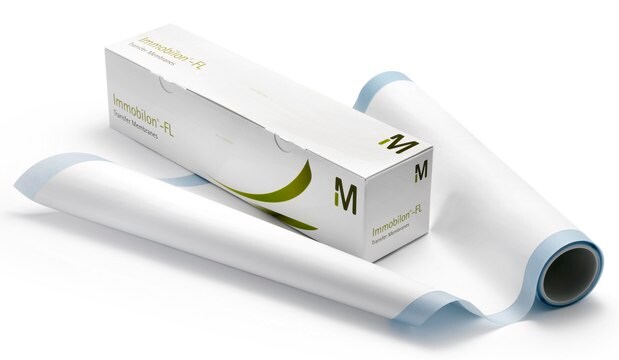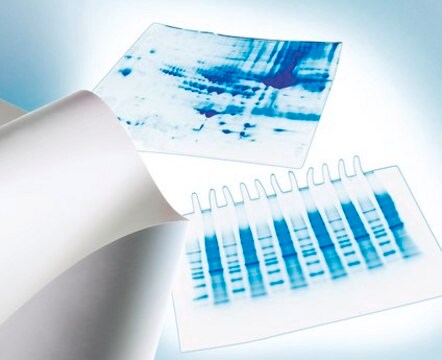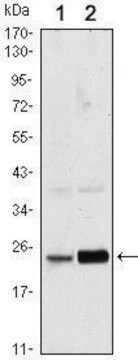추천 제품
생물학적 소스
mouse
Quality Level
항체 형태
purified immunoglobulin
항체 생산 유형
primary antibodies
클론
18B7, monoclonal
종 반응성
mouse
기술
ELISA: suitable
immunocytochemistry: suitable
immunodepletion: suitable
immunofluorescence: suitable
immunohistochemistry: suitable (paraffin)
동형
IgG1κ
배송 상태
ambient
타겟 번역 후 변형
unmodified
일반 설명
Cryptococcus neoformans is an encapsulated yeast-like fungus that is reported to causes systemic infections, including fatal meningoencephalitis. Glucuronoxylomannan (GXM) is the principal constituent of the Cryptococcus neoformans capsule that modulates the inflammatory response of human monocytes in vitro. The basic structural unit of GXM is a tri-mannose repeat with a glucuronic acid residue in the first mannose. Its structure is shown to be further modified in individual strains by the addition of xylose substitutions on the mannan backbone. Six triads known as M1-M2 are shown to be present in various proportions in GXM from the various serotypes and M2 is reported to be the most common triad in serotype A GXM. Soluble GXM serves as an important virulence factor and contributes to the pathogenesis of infection, and high levels of GXM have been found in serum of patients with cryptococcosis. Clone 18B7 displays significant activity against GXM and is reported act by possibly hydrolyzing the oligosaccharide substrate. This antibody acts as a potent opsonin for Cryptococcus neoforman by increasing its phagocytosis. This antibody may also reduce GXM levels by interfering with the release of polysaccharide from the capsule. Administration of this antibody to mice is shown to rapidly clear serum Cryptococcal antigen. (Ref.: Bowen, A., et al. (2017). J. Biol. Chem. 292(2); 417-434; Martinez, LR., et al. (2004). Infect. Immun. 72(6); 3674 3679; Tissi, L., et al. (2004). Infect. Immun. 72(11); 6367-6372; Devi, SJN et al. (1991). Infect. Immun. 59(10); 3700-3707).
특이성
Clone 18B7 is a mouse monoclonal antibody that binds to Glucuronoxylomannan (GXM) from Cryptococcus neoformans.
면역원
Cryptococcus neoformans serotype A glucuronoxylomannan (GXM)-Tetanus Toxoid conjugate vaccine.
애플리케이션
Anti-Glucuronoxylomannan (GXM), clone 18B7, Cat. No. MABF2069, is a mouse monoclonal antibody for detection of Cryptococcus neoformans Glucuronoxylomannan and has been tested for use in and ELISA, Immunodepletion, Immunocytochemistry, Immunofluorescence, and Immunohistochemistry (Paraffin),
Immunohistochemistry Analysis: A representative lot detected Glucuronoxylomannan (GXM) in Immunohistochemistry applications (Lendvai, N., et. al. (1999). J Infect Dis. 180(3):791-801; Casadevall, A., et. al. (1998). Antimicrob Agents Chemother. 42(6):1437-46).
Immunodepletion Analysis: A representative lot immunodepleted Glucuronoxylomannan (GXM) in Immunodepletion applications (Lendvai, N., et. al. (1999). J Infect Dis. 180(3):791-801; Casadevall, A., et. al. (1998). Antimicrob Agents Chemother. 42(6):1437-46; Martinez, L.R., et. al. (2004). Infect Immun. 72(6):3674-9; Bowen, A., et. al. (2017). J Biol Chem. 292(2):417-434).
Immunofluorescence Analysis: A representative lot detected Glucuronoxylomannan (GXM) in Immunofluorescence applications (Casadevall, A., et. al. (1998). Antimicrob Agents Chemother. 42(6):1437-46; Bowen, A., et. al. (2017). J Biol Chem. 292(2):417-434).
Immunocytochemistry Analysis: A 1:1,000 dilution from a representative lot detected Glucuronoxylomannan (GXM) in heat killed cryptococcus cells.
Immunohistochemistry Analysis: A 1:50-250 dilution from a representative lot detected Glucuronoxylomannan (GXM) in S. neoformans-infected mouse spleen, mouse lung, mouse liver, and mouse brain tissues.
ELISA Analysis: A representative lot detected Glucuronoxylomannan (GXM) in ELISA applications (Casadevall, A., et. al. (1998). Antimicrob Agents Chemother. 42(6):1437-46; Martinez, L.R., et. al. (2004). Infect Immun. 72(6):3674-9; Bowen, A., et. al. (2017). J Biol Chem. 292(2):417-434).
Immunodepletion Analysis: A representative lot immunodepleted Glucuronoxylomannan (GXM) in Immunodepletion applications (Lendvai, N., et. al. (1999). J Infect Dis. 180(3):791-801; Casadevall, A., et. al. (1998). Antimicrob Agents Chemother. 42(6):1437-46; Martinez, L.R., et. al. (2004). Infect Immun. 72(6):3674-9; Bowen, A., et. al. (2017). J Biol Chem. 292(2):417-434).
Immunofluorescence Analysis: A representative lot detected Glucuronoxylomannan (GXM) in Immunofluorescence applications (Casadevall, A., et. al. (1998). Antimicrob Agents Chemother. 42(6):1437-46; Bowen, A., et. al. (2017). J Biol Chem. 292(2):417-434).
Immunocytochemistry Analysis: A 1:1,000 dilution from a representative lot detected Glucuronoxylomannan (GXM) in heat killed cryptococcus cells.
Immunohistochemistry Analysis: A 1:50-250 dilution from a representative lot detected Glucuronoxylomannan (GXM) in S. neoformans-infected mouse spleen, mouse lung, mouse liver, and mouse brain tissues.
ELISA Analysis: A representative lot detected Glucuronoxylomannan (GXM) in ELISA applications (Casadevall, A., et. al. (1998). Antimicrob Agents Chemother. 42(6):1437-46; Martinez, L.R., et. al. (2004). Infect Immun. 72(6):3674-9; Bowen, A., et. al. (2017). J Biol Chem. 292(2):417-434).
Research Category
Inflammation & Immunology
Inflammation & Immunology
품질
Isotype testing: Identity Confirmation by Isotyping Test.
Isotyping Analysis: The identity of this monoclonal antibody is confirmed by isotyping test to be mouse IgG1 .
Isotyping Analysis: The identity of this monoclonal antibody is confirmed by isotyping test to be mouse IgG1 .
물리적 형태
Format: Purified
Protein G purified
Purified mouse monoclonal antibody IgG1 in PBS without azide.
저장 및 안정성
Stable for 1 year at -20°C from date of receipt. Handling Recommendations: Upon receipt and prior to removing the cap, centrifuge the vial and gently mix the solution. Aliquot into microcentrifuge tubes and store at -20°C. Avoid repeated freeze/thaw cycles, which may damage IgG and affect product performance.
기타 정보
Concentration: Please refer to lot specific datasheet.
면책조항
Unless otherwise stated in our catalog or other company documentation accompanying the product(s), our products are intended for research use only and are not to be used for any other purpose, which includes but is not limited to, unauthorized commercial uses, in vitro diagnostic uses, ex vivo or in vivo therapeutic uses or any type of consumption or application to humans or animals.
적합한 제품을 찾을 수 없으신가요?
당사의 제품 선택기 도구.을(를) 시도해 보세요.
Storage Class Code
12 - Non Combustible Liquids
WGK
WGK 2
Flash Point (°F)
Not applicable
Flash Point (°C)
Not applicable
시험 성적서(COA)
제품의 로트/배치 번호를 입력하여 시험 성적서(COA)을 검색하십시오. 로트 및 배치 번호는 제품 라벨에 있는 ‘로트’ 또는 ‘배치’라는 용어 뒤에서 찾을 수 있습니다.
Keigo Ueno et al.
European journal of immunology, 51(9), 2281-2295 (2021-03-18)
Cryptococcus gattii is a capsular pathogenic fungus causing life-threatening cryptococcosis. Although the capsular polysaccharides (CPs) of C. gattii are considered as virulence factors, the physiological significance of CP biosynthesis and of CPs themselves is not fully understood, with many conflicting data reported.
Matheus Henrique Dos Santos et al.
Cells, 11(21) (2022-11-12)
Chimeric antigen receptors (CARs) redirect T cells to recognize a specific target. CAR components play a pivotal role in antigen specificity, structure stability, expression on cell surface, and induction of cellular activation, which together determine the success of CAR T-cell
Ya-Nan Li et al.
Nature communications, 13(1), 4074-4074 (2022-07-15)
Cryptococcosis is a potentially lethal disease that is primarily caused by the fungus Cryptococcus neoformans, treatment options for cryptococcosis are limited. Here, we show glucuronoxylomannan, the major polysaccharide component of C. neoformans, induces the recruitment of neutrophilic myeloid-derived suppressor cells
Suresh Ambati et al.
mSphere, 4(5) (2019-11-02)
Candida albicans, Cryptococcus neoformans, and Aspergillus fumigatus cause life-threatening candidiasis, cryptococcosis, and aspergillosis, resulting in several hundred thousand deaths annually. The patients at the greatest risk of developing these life-threatening invasive fungal infections have weakened immune systems. The vulnerable population
자사의 과학자팀은 생명 과학, 재료 과학, 화학 합성, 크로마토그래피, 분석 및 기타 많은 영역을 포함한 모든 과학 분야에 경험이 있습니다..
고객지원팀으로 연락바랍니다.







